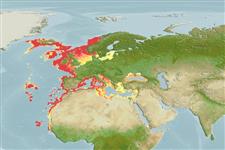| Native range | All suitable habitat | Year 2100 |

|
| Conger conger AquaMaps Data sources: GBIF OBIS |
Length at first maturity
Lm 200.0 range ? - ? cm
Human uses
Fisheries: commercial; gamefish: yes; aquarium: public aquariums
Phylogenetic diversity index
(Ref. 82805)
PD50 = 0.5000 many relatives (e.g. carps) 0.5 - 2.0 few relatives (e.g. lungfishes)
Trophic Level
(Ref. 69278)
4.3 ±0.4 se; Based on diet studies.
Resilience
(Ref. 69278)
Very Low, minimum population doubling time more than 14 years (K=0.06; tm=5-15 (female tm>10); Fec=3,000,000)